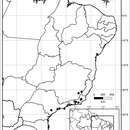Description
provided by Phytokeys
Tree to 8 m, the branching appearing somewhat verticillate with branches in congested groups; young stems terete, completely glabrous, usually shiny; new growth completely glabrous and shiny, in live plants sometimes purplish green; bark of older stems pale yellow when dry, in live plants greyish brown. Sympodial units plurifoliate, the leaves clustered along the stems. Leaves simple, 4.5–16 cm long, 2–5 cm wide, elliptic to obelliptic, usually narrowly so, chartaceous and somewhat brittle, both surfaces glabrous and shiny, drying a golden brown; primary veins 6–10 pairs, drying yellowish brown, not looping in a submarginal vein; base acute to acuminate; margins entire, sometimes revolute; apex abruptly acute to attenuate; petiole (0.5-)1–2 cm long, glabrous, drying pale yellowish brown. Inflorescences 2–5 cm long, terminal, appearing axillary but this due to short internodes and congested leaves, branching 1–2 times, with 30–40 flowers, completely glabrous; peduncle 0.5–2.5 cm long; pedicels 1.5–1.7 cm long, ca. 0.5 mm in diameter at the base, ca. 1 mm in diameter at the apex, filiform, spreading at anthesis, glabrous, articulated at the base; pedicel scars unevenly spaced 1–2 mm apart, usually clustered at the tips of the inflorescence branches. Buds ellipsoid, the corolla completely enclosed in the calyx when young, exserted 2/3 to 3/4 of the way just before anthesis. Flowers 5-merous, all perfect, intensely sweet-smelling (Custodio Filho 305). Calyx tube 1–1.5 mm long, conical, the lobes 0.9–1 mm long, ca. 1 mm wide, broadly deltate, with scarious margins and a central thickened keel ending in a rounded point, glabrous or the tips with a few papillae. Corolla (1.4-)1.6–1.8 cm in diameter, white, stellate, lobed nearly to the base, the lobes 6–8 mm long, 2.5–3.5(-4) mm wide, spreading at anthesis, densely papillate on the cucullate tips, otherwise completely glabrous. Stamens 4.5–6 mm long; filament tube 1 mm long or less, the free portion of the filaments minute, <0.5 mm long, glabrous; anthers (3-)4–4.5 mm long, 1–1.2 mm wide, obellipsoid with the base narrower than the distal portion, yellow, poricidal at the tips, the pores lengthening to slits with age. Ovary glabrous; style 5–7 mm long, glabrous; stigma minutely capitate, the surface papillose. Fruit a globose berry, 1–1.2 cm in diameter, pale green and white speckled (immature) becoming yellow or orange when ripe, the pericarp shiny and leathery, shattering when pressed and dried; fruiting pedicels 2–2.5 cm long, ca. 1 mm in diameter at the base, expanding gradually to ca. 2 mm in diameter at the apex, more or less woody, hanging; calyx lobes in fruit not markedly lengthening. Seeds 10–20 per berry, 5–5.5 mm long, 3–4 mm wide, reniform and somewhat flattened, dark brown with paler margins, the surfaces minutely pitted and usually quite thin the embryo easily visible, the testal cells with sinuate margins.
- license
- cc-by-3.0
- copyright
- Sandra Knapp, João Renato Stehmann, Leandro L. Giacomin
- bibliographic citation
- Knapp S, Stehmann J, Giacomin L (2015) New species, additions and a key to the Brazilian species of the Geminata clade of Solanum L. (Solanaceae) in Brazil PhytoKeys (47): 1–48
- author
- Sandra Knapp
- author
- João Renato Stehmann
- author
- Leandro L. Giacomin

